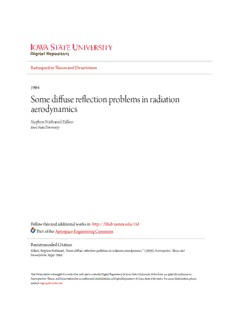
Some diffuse reflection problems in radiation aerodynamics PDF
Preview Some diffuse reflection problems in radiation aerodynamics
Iowa State University Capstones, Theses and Retrospective Theses and Dissertations Dissertations 1964 Some diffuse reflection problems in radiation aerodynamics Stephen Nathaniel Falken Iowa State University Follow this and additional works at:https://lib.dr.iastate.edu/rtd Part of theAerospace Engineering Commons Recommended Citation Falken, Stephen Nathaniel, "Some diffuse reflection problems in radiation aerodynamics " (1964).Retrospective Theses and Dissertations. 3848. https://lib.dr.iastate.edu/rtd/3848 This Dissertation is brought to you for free and open access by the Iowa State University Capstones, Theses and Dissertations at Iowa State University Digital Repository. It has been accepted for inclusion in Retrospective Theses and Dissertations by an authorized administrator of Iowa State University Digital Repository. For more information, please [email protected]. This dissertation has been 65-4604 microfilmed exactly as received FALiKEN, Stephen Nathaniel, 1937- SOME DIFFUSE REFLECTION PROBLEMS IN RADIATION AERODYNAMICS. Iowa State University of Science and Technology Ph.D., 1964 Engineering, aeronautical University Microfilms, Inc., Ann Arbor, Michigan SOME DIFFUSE REFLECTIOU PROBLEMS IN RADIATION AERODYNAMICS "by Stephen Nathaniel Falken A Dissertation Submitted to the Graduate Faculty in Partial Fulfillment of The Requirements for the Degree of DOCTOR OF HîILOSOEHï Major Subjects: Aerospace Engineering Mathematics Approved: Signature was redacted for privacy. Cmrg^Vf Major Work Signature was redacted for privacy. Heads of Mgjor Departments Signature was redacted for privacy. De of Gradu^ e College Iowa State University Of Science and Technology Ames, loTfa 196k ii TABLE OF CONTENTS page DEDICATION iii I. LIST OF SYMBOLS 1 II. INTRODUCTION. 5 HI. GENERAL AERODYNAMIC FORCE ANALYSIS 11 IV. THE THEORY OF RADIATION AERODYNAMICS Ik A. Fundamental Concepts l4 B. Diffuse Reflection and the Principle of Invariance 29 C. Isotropic Reflection 58 D. Anisotropic Reflection 44 E. Comparison between Radiation Aerodynamics and Rarefied Gas Dynamics 5I V. APPLICATIONS OF RADIATION AERODYNAMICS 58 A. Flat Plate 62 B. Sphere "jk C. Cylinder 82 71. DISCUSSION 88 A. Flat Plate 88 B. Sphere 93 C. Cylinder 94 Vn. BIBLIOGRAPHY 96 VHI. ACKNOWLEDGEMENTS 98 IX. APPENDIX 99 lii DEDICATION It is a joy to dedicate this thesis to my wife Laurel, vho provided the serene home environment so perfectly complementary to my research, and -who has "been a pillar of strength and an inspiration throughout. I. LIST OF SYMBOLS Albedo Defined "by Equation 28 Velocity of light Velocity of a molecule Dlmensionless aerodynamic drag coefficient Dlmensionless aerodynamic lift coefficient Defined by Equation 92 Electromagnetic energy Electric field vector Force Flux of radiant energy Force per unit area Boltzmann distribution function Defined by Equation 68 Magnetic field vector Intensity of radiation energy- Emission coefficient Defined by Equation 58 Unit vector Mass of a molecule Defined by Equation 70 Electromagnetic momentum Number density of molecules Unit vector 2 Defined by Equation 126 P Pressure P Probability ?" Position vector R Reflection function R Gas constant S Defined by Equation 53 dS Differential element of length t Time T Temperature T Defined by Equation 122 u Component of ? in x-direction U Defined by Equation 119 V Component of c in y-direction V Velocity of space vehicle dv Differential element of volume V Defined by Equation 120 •w' Component of in z-direction W Defined by Equation 125 X Position coordinate on surface X Defined in Equation 99 y Position coordinate on surface V Defined in Equation 100 z Position coordinate on surface a Angle of attack 5 7 Angle defined "by Equation ^1 6 Dirac ô-function e An angle in the sphere problem 0 Polar angle in spherical coordinates K Absorption coefficient \ Albedo for single scattering, or "degree of reflection" p, Cosine of the polar angle X) Frequency of radiation •fl" Defined by Equation 110 p Density of reflecting material â Accomodation coefficient da Element of surface area dS Element of surface area T Shear stress T Optical thickness (j) Azimuth angle in spherical coordinates X Phase function f Defined by Equation 68 dm Element of solid angle dfL Truncated; semi-infinite cone Subscripts D Drag 1 Incident to surface L Lift n Normal to surface 4 0 Refers to incident parallel radiation r Reflected from surface t Tangential to surface T Total X X component y y component z z component w Maxwell distribution at the surface temperature 5 IL, lETRODUCTION In the year I873, James Clerk Maxwell deduced theoretically that electromagnetic waves should exert pressure on matter. This idea was most revolutionary, and had a startling impact on the world of physics in ' the late nineteenth century, for it was advanced at a time when thwea ve vs. particle nature of light debate was active. Proponents of the corpuscular theory had proposed the possibility that pressure would be exerted by light if the light had a particle nature, and hope was held that experimental proof of the existence of light pressure would deci sively rule out the wave theory. Yet Maxwell was predicting that waves themselves could exert pressure. It was then put squarely up to the experimentalists to verify the idea. Eventually the Russian physicist Lebedev in 190I and the Americans Nichols and Hull in I90I-5 were able to perform laboratory experiments of sufficient accuracy to give unmistakable proof of the phenomenon of light pressure. An excellent discussion of these experiments and of the impact of Maxwell's prediction ont he physics of the times is given by Henry (16), It is today a well established fact that electromagnetic waves transport not only energy but also momentum, and the exchange of this momentum with a materialb ody by the processes of scattering and absorption results ina definite radiation force acting on the body. Although the magnitudes of radiation forces are small, there are cases where they are important and produces ignificant effects. A few such cases will be briefly discussed. The rapid advance of space technology is making itp ossible for space vehicles to penetrate ever more deeply into the vast reaches of outer space.
Description: